Now & New
- Explore
Bihoku Hillside Park Illumination: Holiday Lights in the Countryside
The winter illumination is an annual phenomenon synonymous with Christmastide and New Year’s, and thus, pretty much every urbanized part of Japan has some display of lights or another, big or small. However, in an insular nation where the majority of the land is mountainous and undeveloped, do illuminations exist outside of cities? The short answer is yes, and to some extent these rural illuminations may be better without the distraction of city lights. Though urban illuminations may sport more light bulbs on average and have the advantage of accessibility via public transport, they are subject to the space constraints of streets and surrounding buildings. On the other hand, illuminations in the wide-open countryside can be as spread out as the organizers want and the crowds tend not to get so hectic, but what is hectic is getting there in the first place, especially without one’s own vehicle. In the case of the Bihoku Hillside Park Illumination in little old Shobara, which offers a dedicated shuttle from Miyoshi Station only at night but jack squat during the day, I took it upon myself to dig up a way for tourists on a budget to get to the park at any time of the day or year without a car or taxi.
Journey to Bihoku
Getting to Shobara City from Hiroshima City may take a while since it’s on the other side of the prefecture, but all it takes is one JR train from Hiroshima Station. From Miyoshi Station, take the Sanjo Bus Line (三城線) to Kumanoguchi (熊野口) the closest bus stop to Bihoku Hillside Park. It’s about a 20-something-minute walk to the park, but that shouldn’t be an issue given how much walking one does inside that park anyway. The first thing to do after alighting the bus is to cross the street in order to be on the same side as the police station. With the police station on the left-hand side, cross over the railroad tracks and advance along the broad, winding country road for about twenty minutes until the park entrance comes into view. I took some time to memorize my surroundings while the sun was up so that the return journey in the dark wouldn’t be so intimidating. Eventually, I came across an unlit sign indicating the entrance to Bihoku Hillside Park, and after circling the spacious parking lot, I bought my ticket and went in.
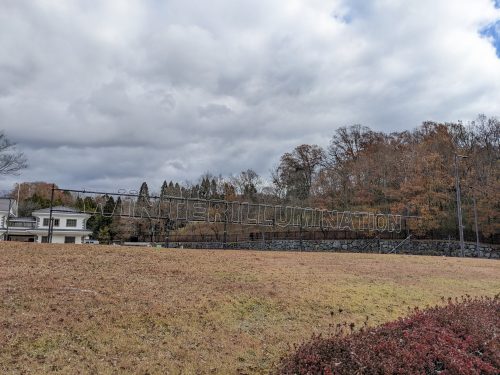
Though it was the nighttime illumination that drew me here in the first place, I figured that it would be worth more my while to see what this park has to offer during the day, especially considering I was visiting for the first time. It was fast approaching 2:00 p.m. by the time I got inside and I was dying for something to eat, but the restaurant by the entrance didn’t entice me that much so I decided to look for food further within. Luckily, the sparkly Road Train was parked right there and ready to roll at 2 o’ clock sharp, so I bought my ticket and waited inside the first car until the train started chugging me around the park.

The Road Train traveled in a clockwise direction along the same path pedestrians and cyclists would take, and all the while, passersby stared and waved at me and the conductor as we chugged by at a pace that I would probably outrun on my own legs. We initially passed by part of the illumination site that would later be lit, which got me further pumped for the main event. The train also provided narrations explaining the various locations we passed, such as this playground with a structure somewhat resembling the Holstentor in Lübeck, Germany.
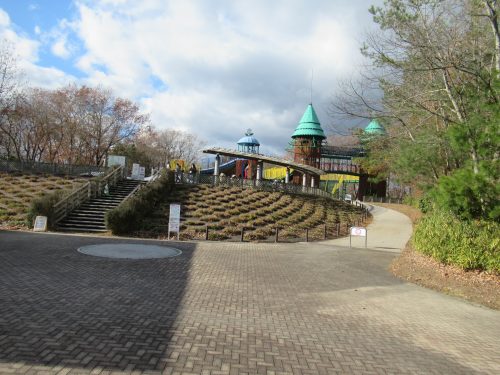
Tiny Late Lunch Break
The train also passed by a couple of different rest houses and a ground golf course before I rang the buzzer to dismount at a place called “Kyu no Mori Rest Area,” which had a hilltop visitor center that commanded a beautiful vista of the Kunigane Lake (国兼池). As I made my way up the stairs to the building, I gazed upon several families, couples, and such running and playing on the expansive, grassy knoll; if you have any sports equipment or outdoor toys lying around your home, here would be the place to use them.
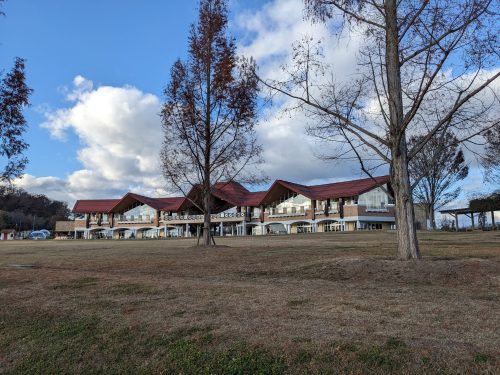
When I got to the building, I approached what looked like a restaurant and was ready to chow down on a late lunch when I realized that lunch was only served until 2:00 p.m., and it was already 2:20! I looked aimlessly at the food ticket vending machine inside, searching for a suitable snack in place of lunch, before I finally went with a deep-fried curry bread. It was super-crunchy on the outside with a spiced beef filling on the inside, but as with any hot curry bread I bite into, there’s always at least one quadrant that feels a little cooler than the others, giving away the fact that this bread was chilled or frozen (a fact I would rather not know).
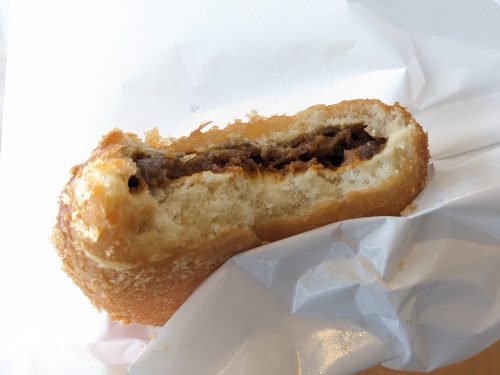
After finishing my food, I stepped outside to explore the adjacent rose garden and admire the lovely flowers thriving within. In Japan, May and October are the prime months for roses, so I was pleasantly surprised to see roses going this strong on the 2nd of December with some still in the process of opening up! I spent longer than I thought I would spend photographing the roses here, but there really is no such thing as too much time spent gazing at flowers.
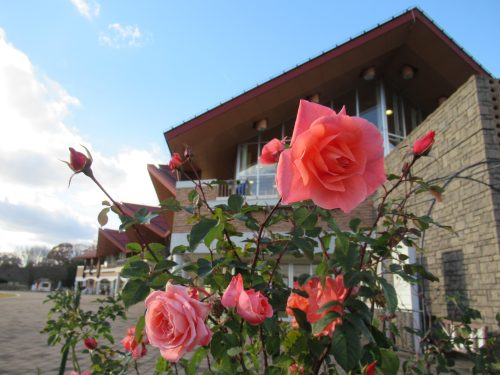
Since the Road Train left me at Kyu no Mori Rest Area and wouldn’t be coming back for the rest of the day, I had no choice but to huff it back to the plaza by the entrance using the same path the train took. The path is properly divided into bicycle and pedestrian lanes so those walking can do so at a carefree pace, but it still pays to pay attention to one’s surroundings once in a while. I was on a bit of a time crunch as I wanted to be back before sundown, and in addition to the walk taking over 20 minutes assuming all I did was walk, there were still other stops to be made before the park closed at 5:00 p.m. On the bright side, I consistently had a wondrous view of the lake to my left as I wound around back to where I started.
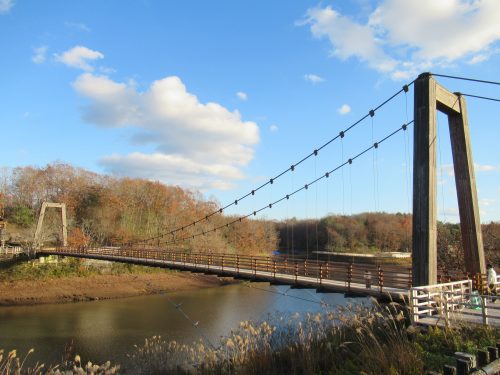
Grown-up Playtime
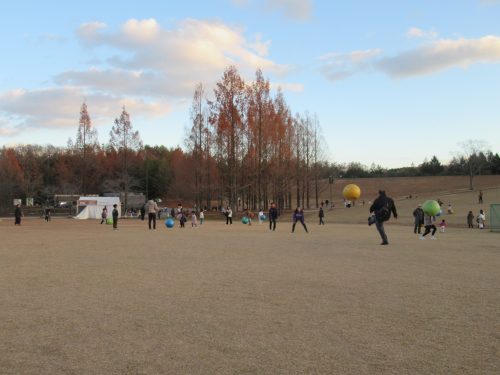
Eventually, I ended up at a wide-open field with an enormous jungle gym and a multitude of families playing all sorts of sports on the grass. As I had only had a single fried curry bread for lunch, I opted to take another breather here, and since there were food trucks and stalls lined up along the path, I had to mull over my snack of choice. I went with a cup of corn potage soup in order to warm up and get my share of veggies for the day. There were plenty of benches in this area, so I plopped myself down and leisurely indulged in this savory concoction, which included croutons on top and more corn kernels than I would expect from food truck cuisine.

After finishing my food, I figured it was time for me to have a turn at the playground, especially the two roller slides that jutted out from the ginormous jungle gym. It was without a doubt the most popular part of the jungle gym, with kids and adults (with their own kids) lining up to have a go. When my turn came, I made sure to bust out my camera to record this memorable ride. After two rounds on the thing, the staff came to announce the closing of the playground and get everyone out of there. Perfect timing, because that meant I could simply proceed to the illumination site and nab even more piping hot snacks!
Moment of Joy: Quite Delicious, to be Frank
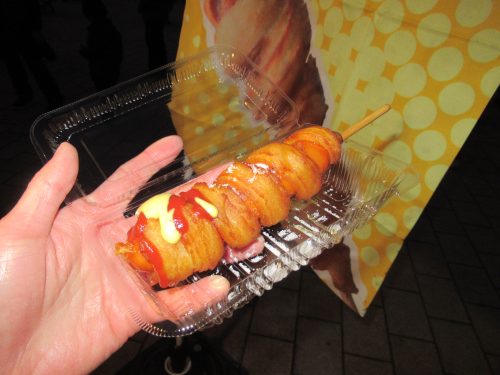
Before the sky had a chance to get dark, I made it back to where I initially boarded the Road Train and the scenery had livened up a whole lot. In addition to food stalls, there were also stands selling glow-in-the-dark toys for the kiddos, but the highlight of my night was finding an item even more unique and colorful that any glowing trinket. It was a hot dog on the stick wrapped in a churro and topped with the customer’s choice of ketchup and mustard, sugar, or honey, but I was indecisive between the three flavors. The shopkeeper offered to top my frank with all three, with each third tasting like a different product. I greatly appreciate his consideration and accommodation to my indeterminacy, and this downing this special snack pumped me up for the Bihoku Illumination that had just gotten underway.
Lights High and Low
Once the lights were fully on inside the park, I started checking out the luminescent wire sculptures, which came in a variety of themes. Near the front, there were many objects related to outer space, such as extraterrestrials, celestial bodies, and a rocket ship. Naturally, photographers besides myself congregated in this area to snap mesmerizing pictures of this cosmic landscape (spacescape?), whose beauty was doubled by its reflection in the pond.

In the back, there was an illumination display showing a more traditional Japanese landscape with the classic structures that tourists love so much. Maybe the G7 Summit in Hiroshima City had something to do with it, but the folks in Shobara ensured that the most amazing side of Japan be shown by including a light-up five-storied pagoda, deer as a nod to Miyajima or Nara Park, wagasa (和傘 – Japanese-style parasols) stuck into the ground, and even a miniature imitation of the tunnel of torii gates at the Fushimi Inari Shrine in Kyoto. Unbeknownst to me at the time, this would be the venue from which that night’s fireworks were to be launched.
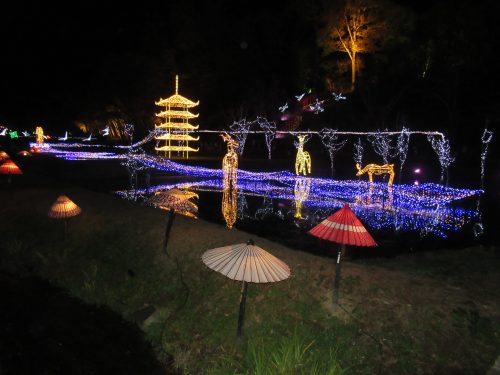
The Bihoku Illumination isn’t just held on weekends, but every Saturday during the holiday season is when fireworks are put on not too long after the start of the illumination. According to the schedule I had put together before my visit, the end of said fireworks display was also my cue to leave Bihoku Hillside Park and skedaddle for the Kumanoguchi bus stop in order to get home. Naturally, that meant that if there was anything else I wanted to buy, I would have to do so before the show started. The last snack I got that day was a perfect fit for autumn in spite of the temperature outside: a baked sweet potato topped with caramelized sugar (watching the worker burn it with a blowtorch was worth the price) and a scoop of vanilla ice cream. The weather was cold, so I had to take my food inside to warm myself up enough to actually eat it.
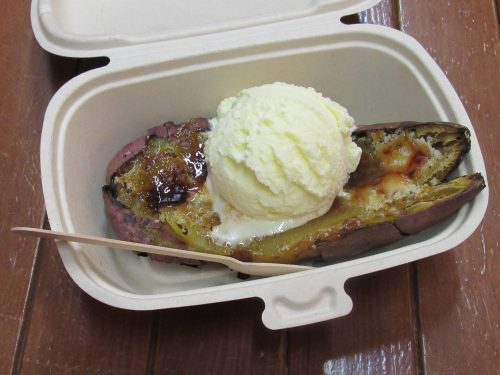
At last, the time came to see the fireworks, but at first, I had no idea from where they would be set. I though they would be launched over the pond with the cosmic display, so I stood halfway up the hill in order to overlook the pond and supposedly have an optimal vantage point. The crowd around me wasn’t too bad, but that’s because I had picked the wrong spot to observe the fireworks. As a result, the fireworks were a bit of a challenge for me to spot through the trees, but I believe I saw enough from where I was. There weren’t as many explosions as I had expected there would be, and the overall atmosphere was rather quiet considering the occasion; with Christmas three weekends away, I was expecting a lot more audible merriment.
Right when the spectacle ended, I had to book it out of the park and down the same path I took when I got here, except everything was pitch black. With this part of Shobara being the middle of nowhere, the sidewalk was poorly lit, but luckily, I always pack a flashlight on my adventures for situations like this one. As expected, I arrived at the bus stop just in time for the last bus of the day to take me back to Miyoshi Station, from which I took a train straight back to Hiroshima City.

Visiting Bihoku Hillside Park the way I did to see it during the day and at night was no doubt tiring on the body, but a rewarding experience for those who want to see quite possibly the greatest illumination in Hiroshima Prefecture (yes, it beats out Dreamination)! Considering its rural location, Shobara is actually more accessible than meets the eye; it’s just Bihoku Hillside Park that requires more effort, but after learning Kumanoguchi, I’ll never take a taxi there. This visit in the onset of winter has inspired me to see Bihoku Hillside Park in the remaining three seasons, and now that I’m acquainted with the park’s layout and facilities, I’m bound to get more mileage with each subsequent visit. Next holiday season, when planning which illuminations in Japan to see, whether in Hiroshima Prefecture or not, do be sure not to discount the caliber and worth of countryside sites. Making the arduous journey to a rural venue like Shobara just might help you see the light as well.
Written by the Joy in Hiroshima Team
